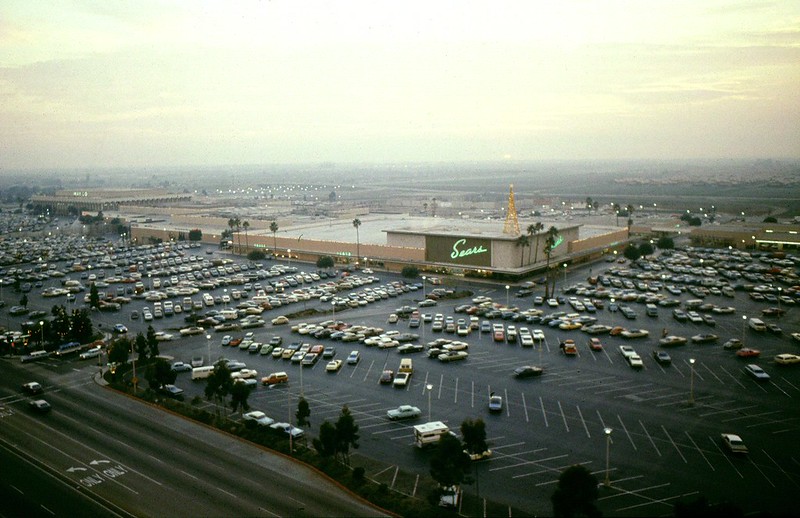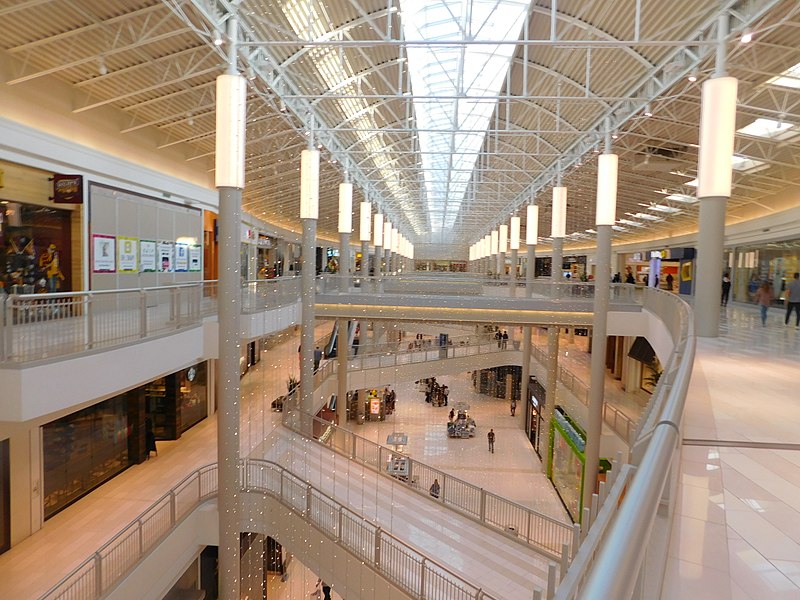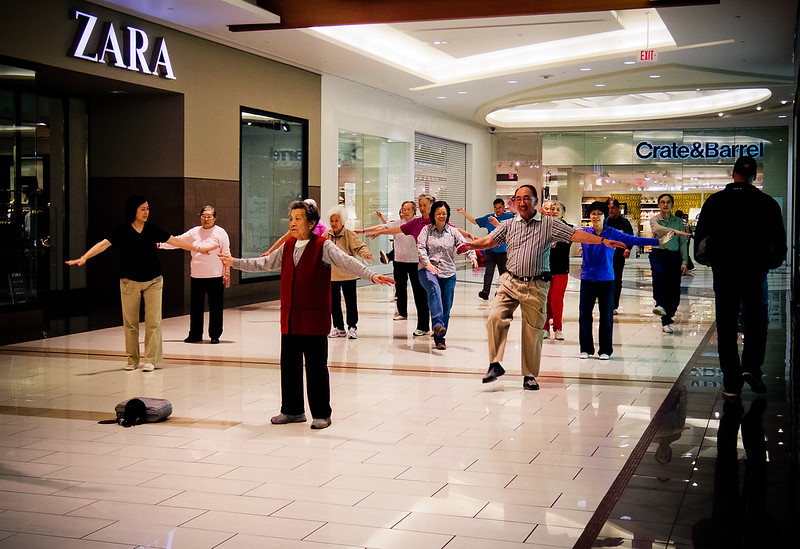It was the 80s. You went to the mall even while you hated the mall. Until you realized that maybe you didn’t hate the mall. Leif Pettersen explains how he came to see the virtue in this suburban American vice thanks to the Mall of America.
Bless me Father, for I have spent my 46th birthday at Mall of America, riding theme park rides, ogling sharks, consuming inappropriate amounts of chocolate, sampling expensive whiskey, and eating meals that even a grizzled travel writing veteran had to admit were pretty great.
Before that WTF? look on your face becomes permanent, you should know that spending a birthday, or even a Wednesday, at a mall was inconceivable until recently in this or any nearby variants of the multiverse. That birthday was the cherry on top of a circuitous, emotionally complicated history with malls, and as Black Friday and the holidays loom, I’ve been invited to share that journey and the unlikely perspective adjustments that came from it.

Malls were an indelible part of coming of age in the 1980s. They were like a combination state fair and carnival, soaked in a thick, tropical mist of teen hormones where, if MTV was any indication, concerts by denim-clad, scrunchie-wearing pop stars might spontaneously break out at any moment.
In the ‘80s, adult supervision of anyone over the age of nine or 10 was optional, so kids were frequently dropped off at malls (and arcades, parks, roller rinks, you name it) and left to their own devices with only a quarter and a payphone to stay connected to their parents. If an emergency arose, we just handled it.
How could people, self-possessed adult people, hear the phrase “Hey, let’s go to the mall” and think that was a really good idea? I soured on the concept in a hurry and soon only a life-or-death situation like an exclusive movie premiere or, for a time, a Krispy Kreme donut run, would compel me to journey out to Mall of America.
Like most people, my mall adventures started while my brain was too undeveloped to have strong opinions about anything except candy and Sesame Street. As I entered my tweens and teens, with the newfound freedom to get myself out to a mall without a ride from a beleaguered parent, mall visits became routine, including Southdale Center in Edina, Minnesota, the first enclosed, climate-controlled mall of the modern era and only a few minutes drive from where I grew up.
With untold hours of independent, unscheduled time at our disposal, one could see a movie (two, if you timed it right and sidled into another theater as the first one was letting out), roam the food court, consume day-after-Halloween quantities of sugar and loiter freely in stores like The Sharper Image, where there was zero chance we had enough money to make a significant purchase.
A couple years later, our increasingly attractive, opposite-gendered classmates presented a new mall incentive, involving gawky communion, rather than militant avoidance. Mine was a strictly binary world in the early-80s, outside of Liberace and maybe Freddie Mercury — we weren’t entirely sure about him yet.
I was 22 when Mall of America, the country’s first “mega-mall,” opened in Bloomington, Minnesota. My girlfriend dragged me out there on the first weekend. By then, the innocent wonder and seemingly unlimited potential of a day at the mall had begun to wane in my mind. I had maybe a mall hour in me before my feet hurt and I became debilitatingly sleepy.
My personal mall fitness aside, this was about the same time that I became conscious of the remarkably polarizing feelings malls inspired in people. How could people, self-possessed adult people, hear the phrase “Hey, let’s go to the mall” and think that was a really good idea? I soured on the concept in a hurry and soon only a life-or-death situation like an exclusive movie premiere or, for a time, a Krispy Kreme donut run, would compel me to journey out to Mall of America.
I carried the anti-mall flag for two decades. Why in Baby Jesus’ name would I drive 30 minutes to park half a mile from the store that had the thing I needed, when I could get it in my neighborhood or, worst case scenario, easily accessible Downtown Minneapolis?
It wasn’t until my mid-40s that I finally understood that I wasn’t considering the situation from the proper perspective. The impulse to meander around a sterile, bright, gaping mega-mall had deeper implications than shopping free-for-alls, treat yo’ self indulgence or inching up to an age-appropriate hottie in line at Jamba Juice to attempt a stammering, rambling conversation.

This late epiphany occurred while I was serving as — wait for it — Mall of America’s Tourism Communications Manager. Job openings in Minnesota tourism media and marketing, the arenas that I’d accidentally become quite skilled at while working as a travel writer for 12 years, were and still are discouragingly rare. And boy did I need a job when travel publishing went into a death spiral after the 2008 economic crash finally caught up with the industry. If the job description hadn’t been an almost exact line-by-line match to my résumé, and if I didn’t have a mortgage to pay for a condo I was quite attached to, I’d never have considered shilling for what I’d been referring to for years as the “Mall of Hysteria.”
I’d come to realize many years earlier that, boiled down to its essence, tourism is merely the search for happiness and fulfillment. And while it’s now a fairly well-documented fact that shopping and acquiring new shit, at best, results in a fleeting uptick in happiness, I recognized that Mall of America was providing the same experience as, say, bungee jumping or indulging in a Michelin Star meal. The pursuit of happiness, which, along with life and liberty, is what this deeply flawed, often embarrassingly misguided country was founded on. Assuming no one is getting hurt, and no cellphones are playing music through the speaker at full blast anywhere near me, this pursuit should be everyone’s individual prerogative.
And while it’s now a fairly well-documented fact that shopping and acquiring new shit, at best, results in a fleeting uptick in happiness, I recognized that Mall of America was providing the same experience as, say, bungee jumping or indulging in a Michelin Star meal.
This is how I approached my work and the legitimately broad appeal of the Mall of America itself. While a mall visit was never going to break into the list of the Top 147 Things I Like to Do With My Free Time, Mall of America was releasing endorphins, or at least a means to a shopping end, for some 40 million people every year. Incidentally, that’s more people than visit Disney World every year and even — don’t ask me how they calculated this — more visitors than Times Square. It wasn’t the most noble tourism work I could have been doing, but I was playing a role in making an astounding number of people happy. My conscience was clear, and I didn’t have to move to Los Angeles or Florida to keep working in my field of expertise.
Moreover, in the case of Mall of America, the statewide tourism boost it has provided over the past quarter century is an undeniable and key component of the popularity Minnesota tourism enjoys today. While some people may descend on the Mall, go on a shopping spree, then drive directly back to Winnipeg, most people stay and use the visit as an opportunity to take in other Twin Cities and Minnesota activities and attractions. If not for the Mall generating millions of additional drive and fly-in visitors, I shudder to think about the state Minnesota tourism would be in right now. That’s tens of thousands of jobs that wouldn’t otherwise exist and untold billions of dollars in supplemental money flowing into the Minnesota economy.
As the Death of Malls has been foretold for 20-some years now, and indeed many have shuttered, the ones that survive are offering visitors far more than Forever 21, Hot Topic and Cinnabon. Malls that are still flourishing now offer unexpectedly excellent dining options (don’t worry, they still have a Panda Express), theme parks, flight simulators, aquariums, and year-round events, some with legit, big-name celebrities.

Actual shopping at Mall of America has almost become ancillary. Walkers show up at 7 a.m. to get their steps in during winter. Teenagers, as always, do little more than roam, flirt and paw stuff with Cheeto-stained fingers they have no intention of buying. Stay-at-home parents, nannies and mannies cruise around, happy to just be out of the damn house and talking to other adults. And the full range of humanity comes together on 98-degree days in August to soak up free air conditioning.
Malls may be gaudy, they may promote turbo-infusion of type 2 diabetes, and they may be the ultimate representation of America’s post-war wretched excess. But we pioneered the damn things and for better or worse we still own that legacy, with pride even, despite the fact that, as with most things “American,” other countries are now doing it far better.
No matter your stance on behemoth odes to capitalism, malls have civic value. People gather for community events, celebrations and inaugurations, to meet friends, sit and watch the world go by, and protest social injustices.
With the haphazard development and sprawl of most American cities, I think it’s fair to say malls have evolved into town squares — town squares with a Hooters and parking for 12,000.
